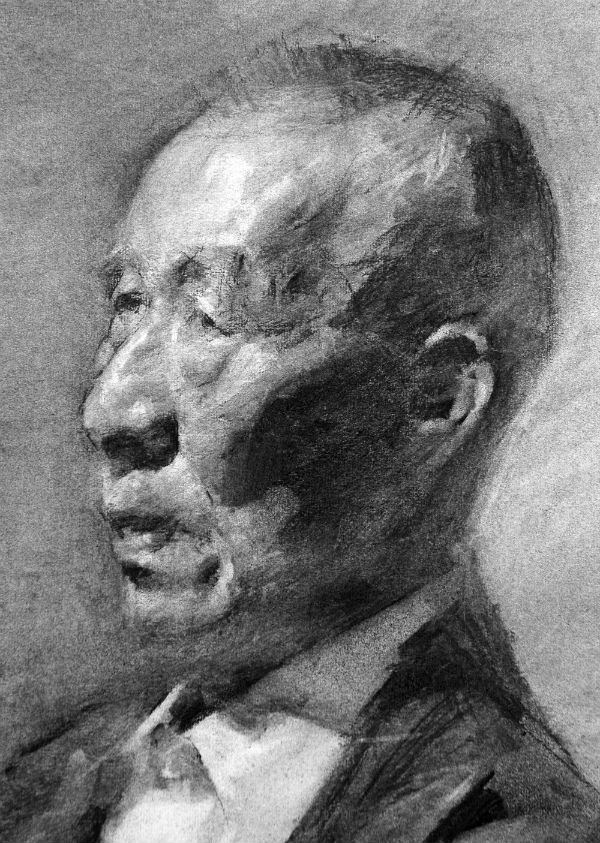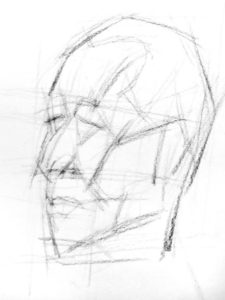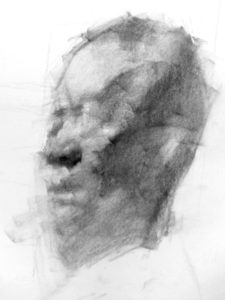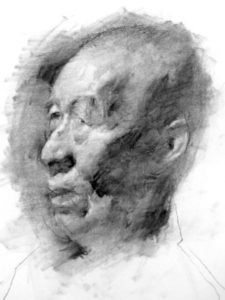The eyes are challenging. A common mistake is to make the eyes either too high or too low. Even an experienced artist needs to be very careful. If the proportion is inaccurate, it affects the entire drawing. This can be avoided by using straight lines during block-in which makes it easier to accurately estimate the proportion and position of the eyes.
Another mistake is to use hard edge, contour lines to reinforce the eye lids and eye balls which often results in the eyes appearing stiff and out of place. This can be avoided by focusing on the entire shape of the eye instead of drawing the eyeball at the beginning. Avoid adding details to the eye lids and eyeballs during block-in.
Wrinkles
When the model is a senior, all too often, we feel the wrinkles are very visible and clear. But they’re not really as visible as they appear. Avoid making the wrinkles so dark that they are out of place. Additionally, avoid defining the wrinkles during the block-in stage. Wrinkles should be addressed last along with other details of the face so that all the details are in sync.
Nose
A common mistake is that we sometimes make the nostrils too dark and too defined. The nostrils should be inside the nose in the shadow. During block-in, hatch the entire shadow area. Define the nostrils during the last stage when other details are defined. Avoid defining them during block-in. Defining them at the beginning is easy to make them too dark and out of place.
Other watch-outs
When we do head drawings, one concern is there is a lack of structure, i.e. bone structure because of a lack of anatomical knowledge.
Another concern is a lack of detail. There are many details to each part. This is very confusing or challenging to a beginning artist.
Third, after a while, the artist can see all the details, get all the details, but is reluctant to give up any of them. So all the details are included. Reluctance to give up unnecessary detail is also a challenge.
Consider the following when drawing a portrait
Before we delve into the details of the facial features in a head portrait, we first need to have in-depth knowledge of head anatomy. If a head portrait is lacking in likeness and spirit, it’s often due to a lack of understanding of head anatomy. As a result, the bones and muscles are out of sync.
Use straight lines during block-in. The benefit of using straight lines instead of contour lines in block-in is that it’s easier to accurately estimate the proportion of each major part and their positions and therefore, more effective in achieving accuracy.
When we work on facial features in detail we should avoid working on facial parts one at a time. We should work on the face as a whole. When observing, look at the sitter with a squint, feel the rhythms in the details and then “translate” them to a variation of strokes to bring the work to life. At the same time, pay close attention to the personality of the sitter, especially his eyes and mouth. Observe carefully and draw with passion to vitalize the image.
For the light areas, pay attention to the half tone. For the dark areas, pay attention to the variation in dark value. Make sure it’s not overly simplified and smooth that it looks like a photo. It’s a drawing after all, not a photo. Lastly, remember to keep the feel of “facets” of different parts.
For information on drawing courses, please click here.
For information on Lessons in Masterful Portrait Drawing, please click here.







